Every organization is heavily dependent on technology to execute its day-to-day operations. This has made software engineering one of this era’s most exciting, promising, and sought-after careers. However, this does not mean getting a job is easy, so it is crucial to design a perfect resume when applying. This will give you a competitive edge over your peers.
The key elements of a software engineer’s resume will be covered in this article, along with some crucial advice for writing a strong CV and free templates that are simple to modify.
Free Software Engineer Resume Examples and Templates
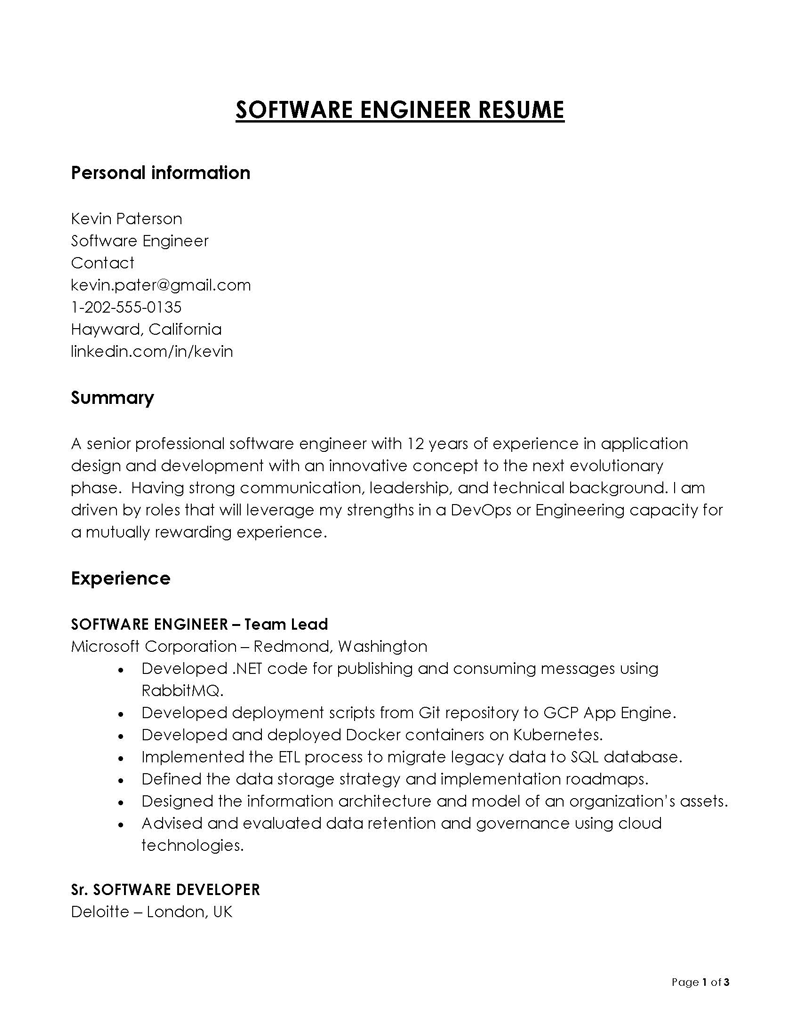
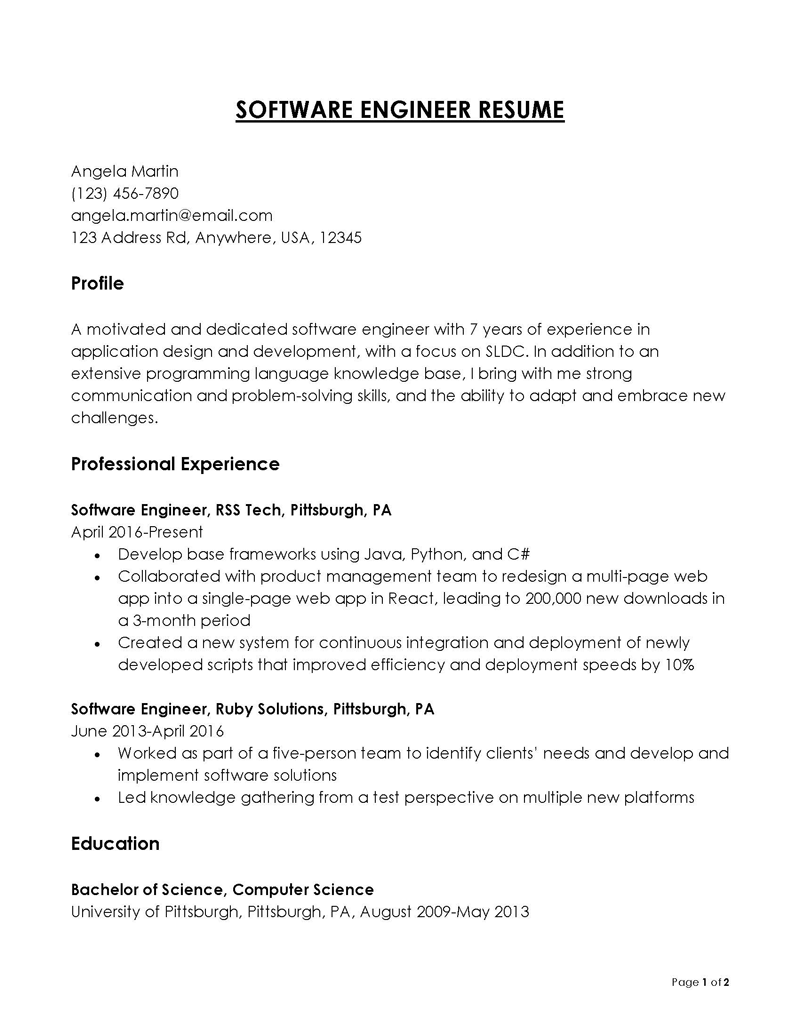
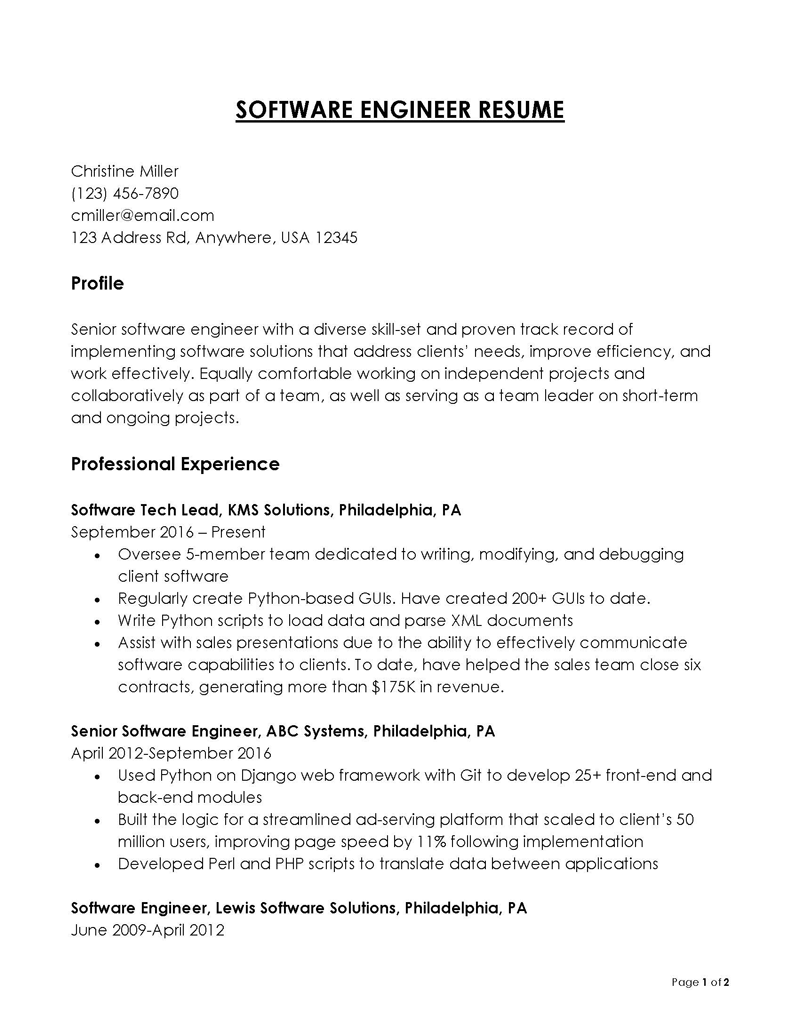
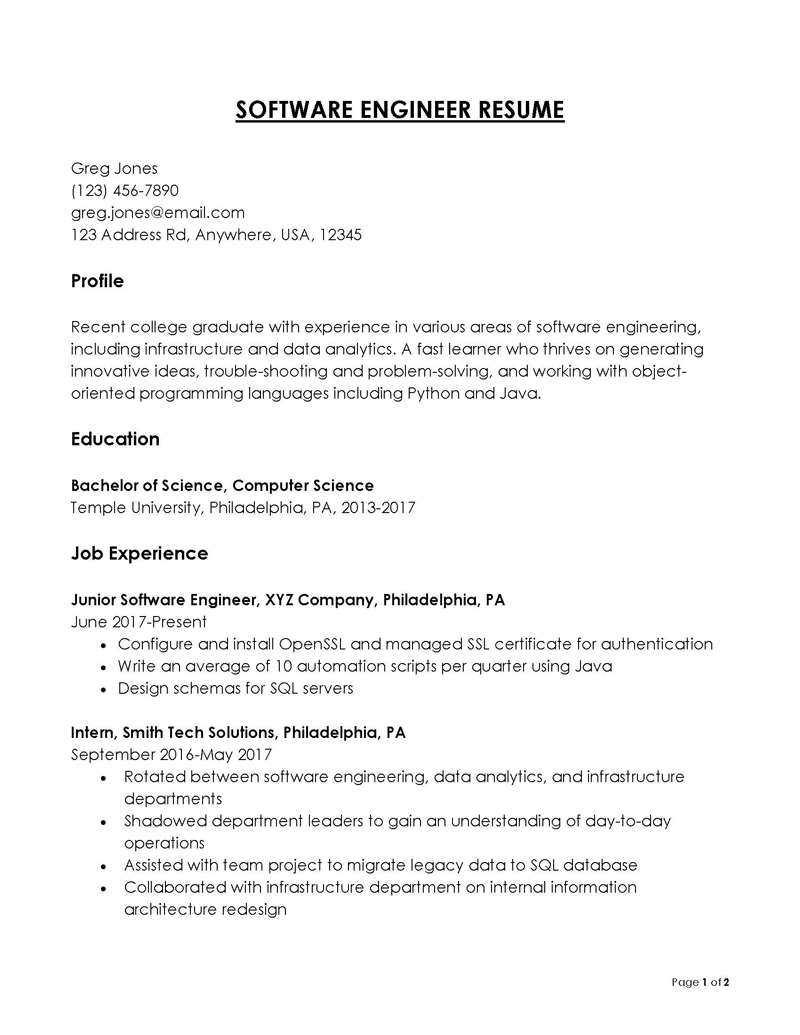
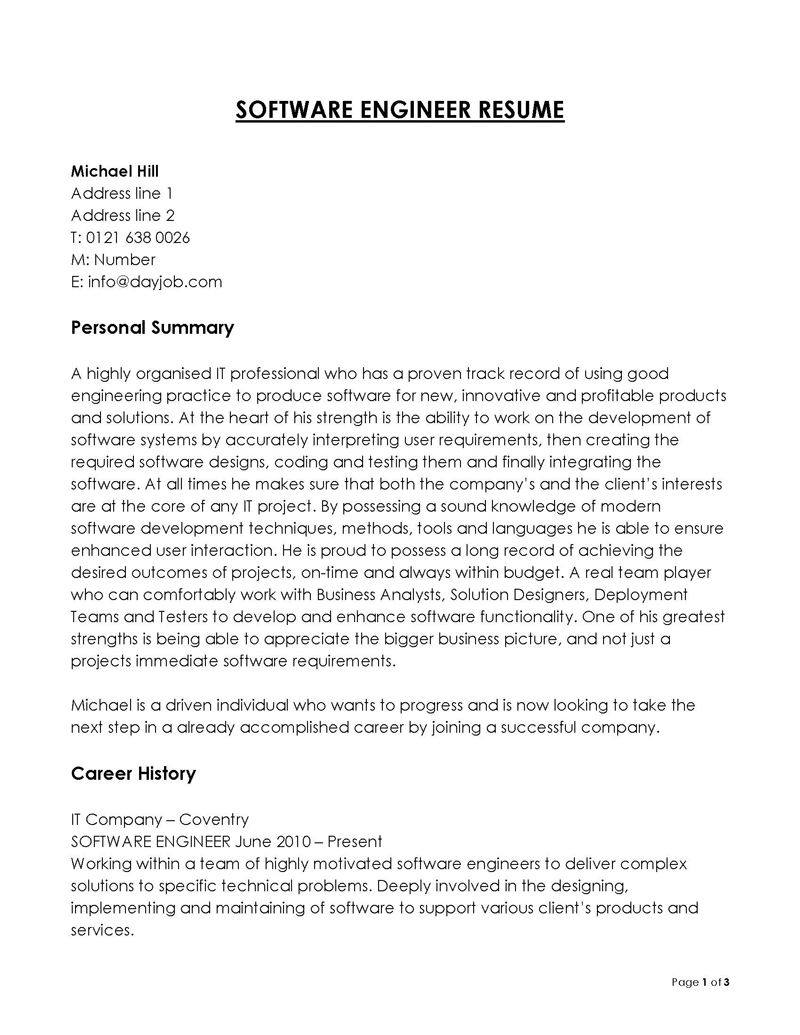
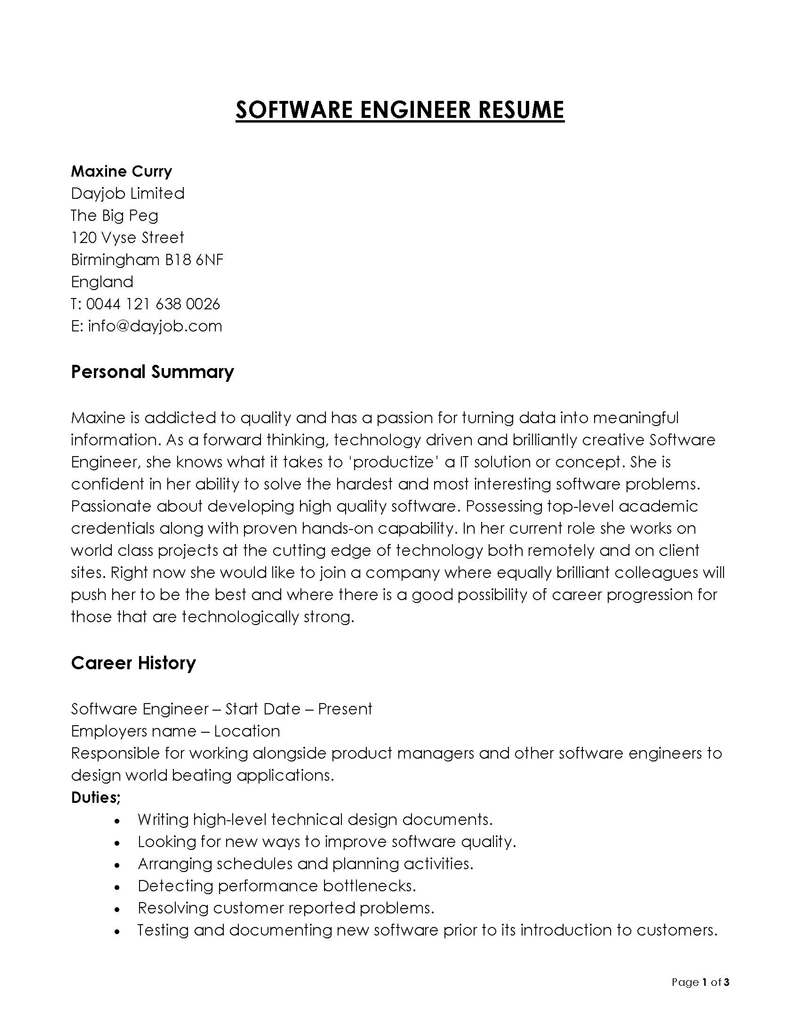
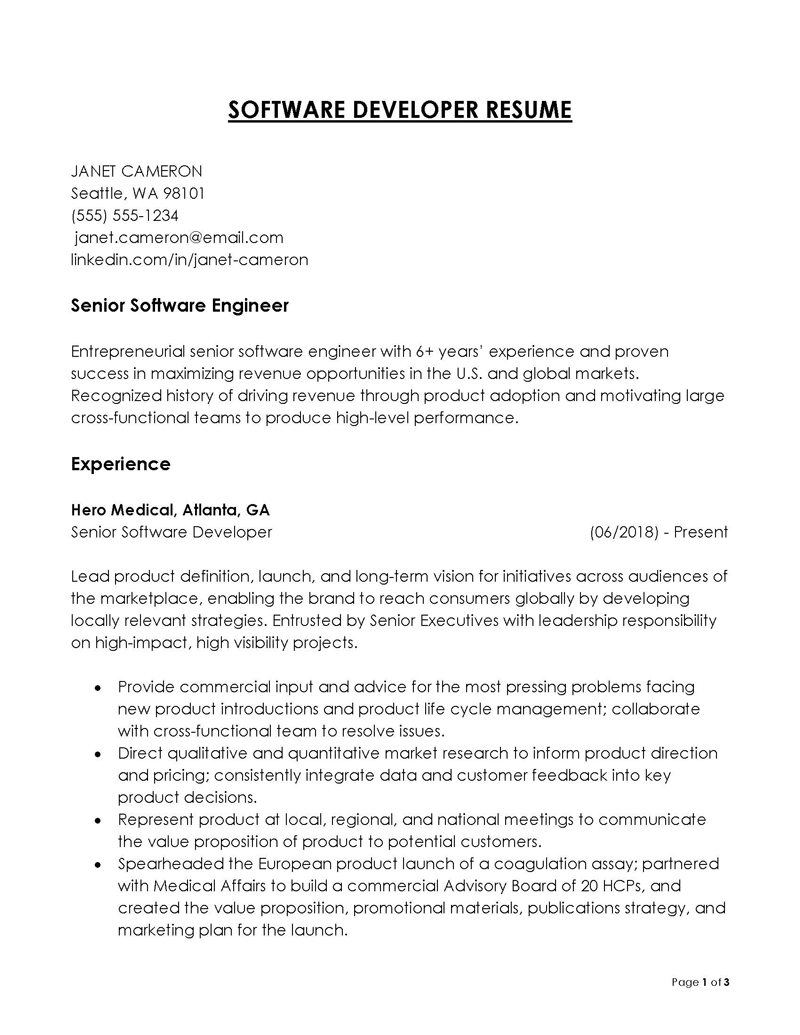
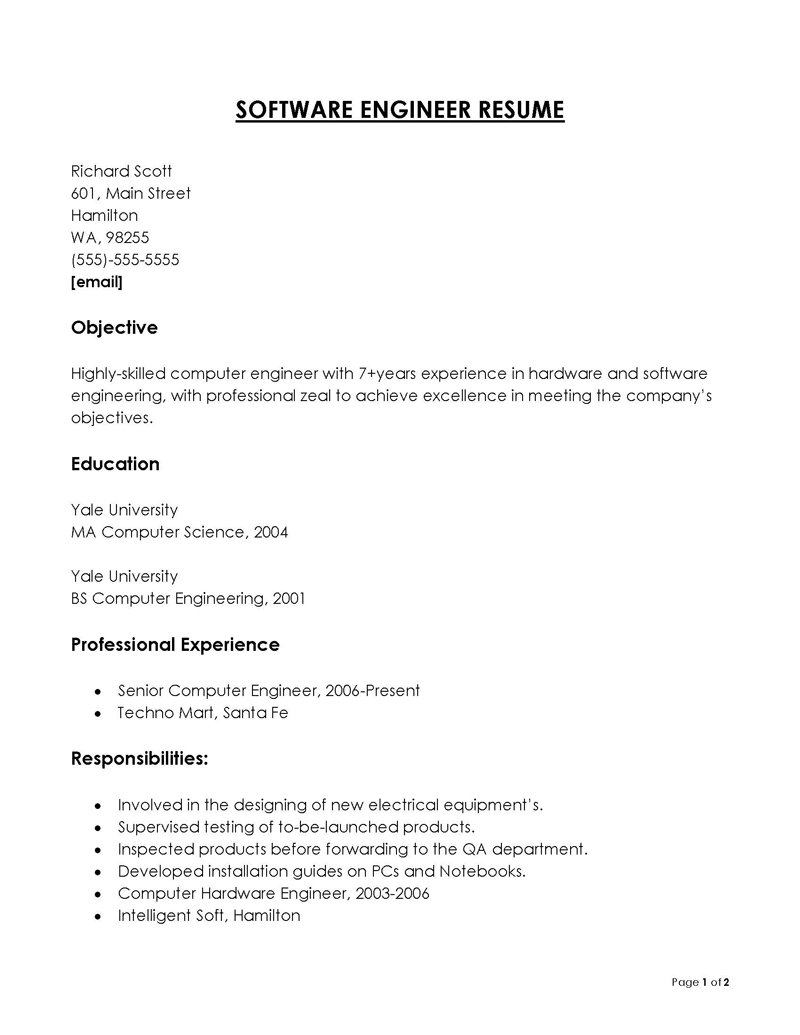
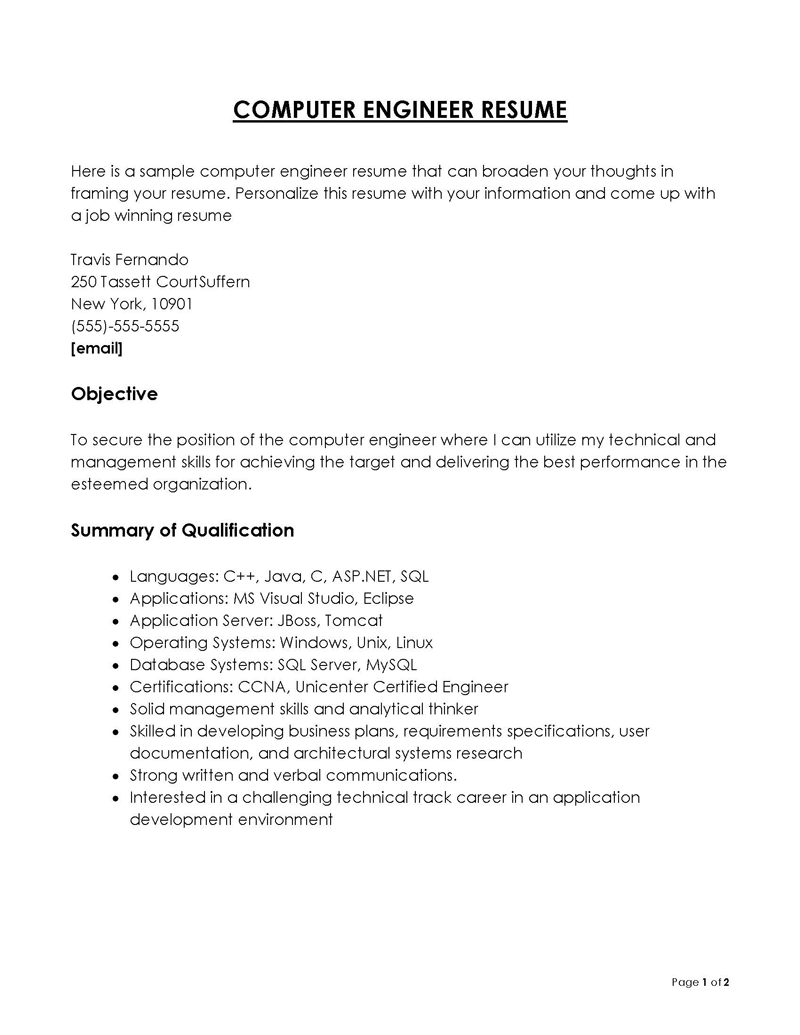
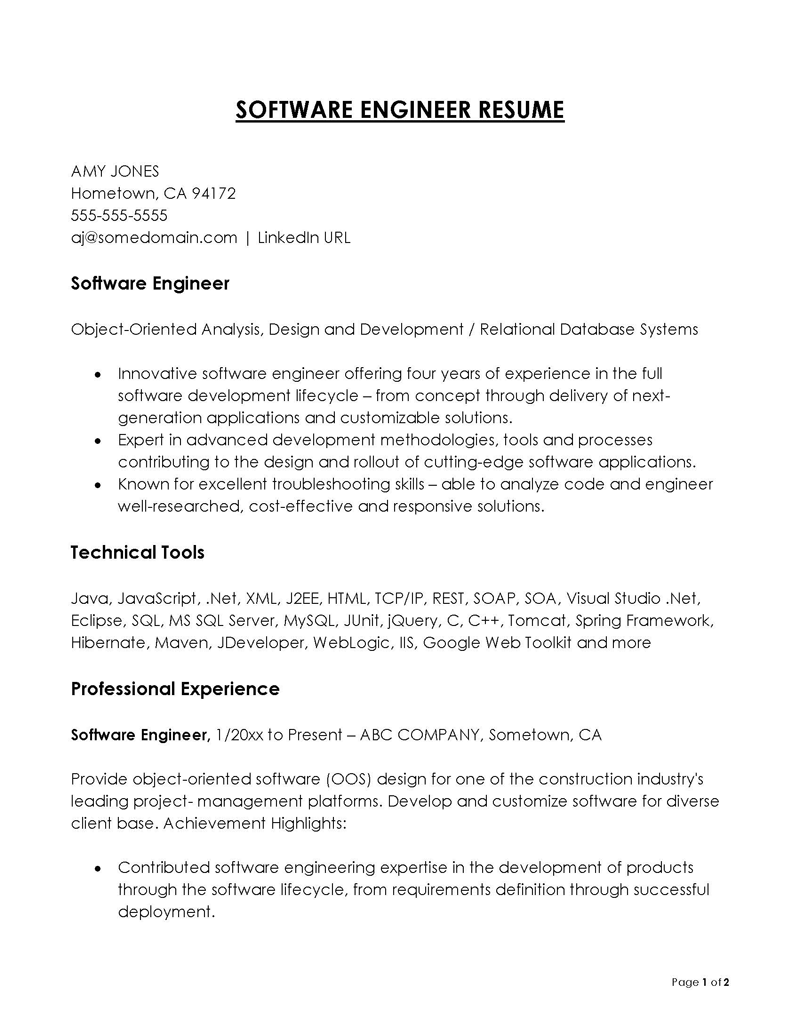
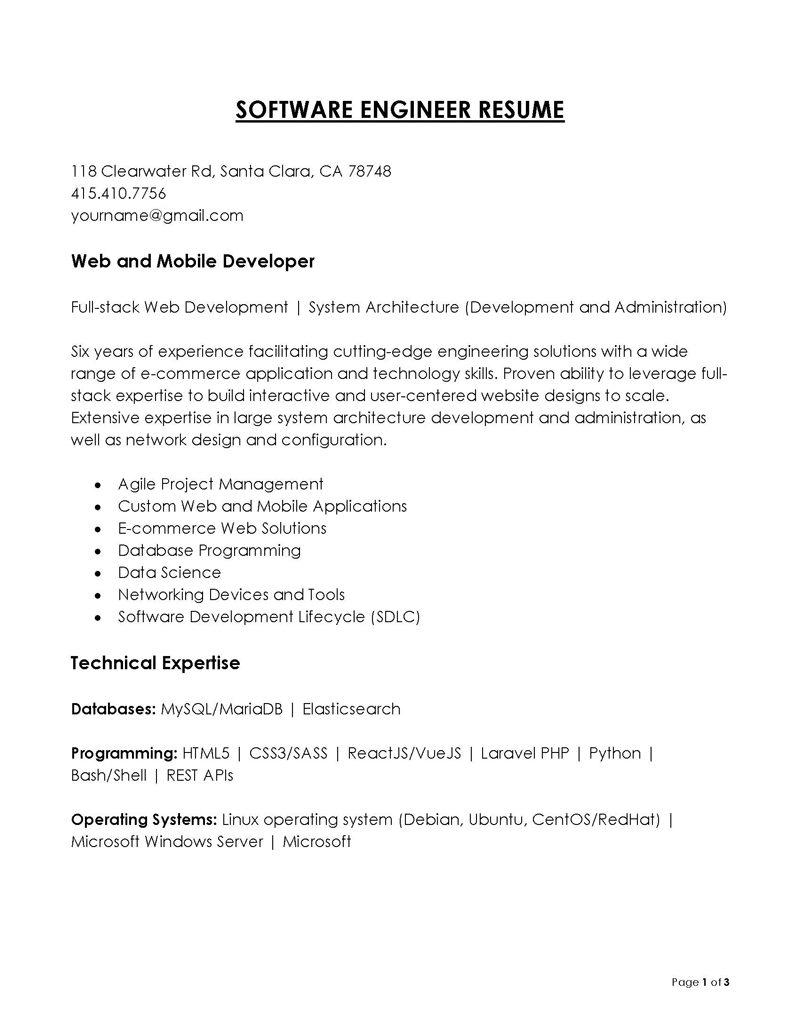
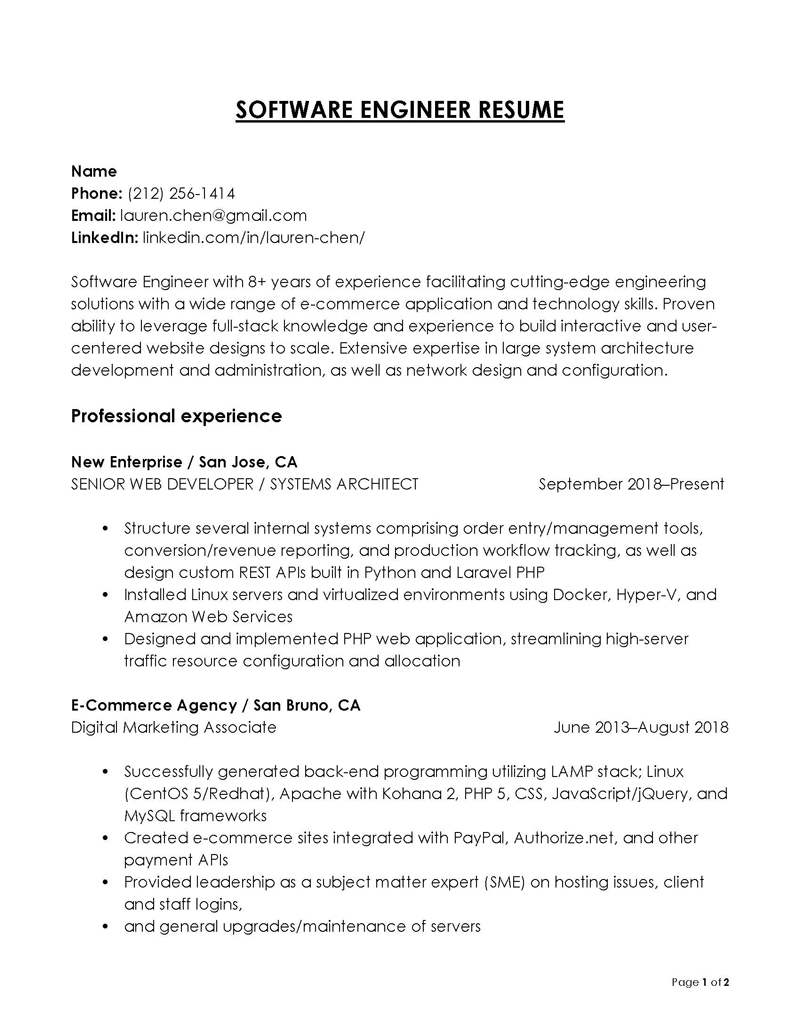
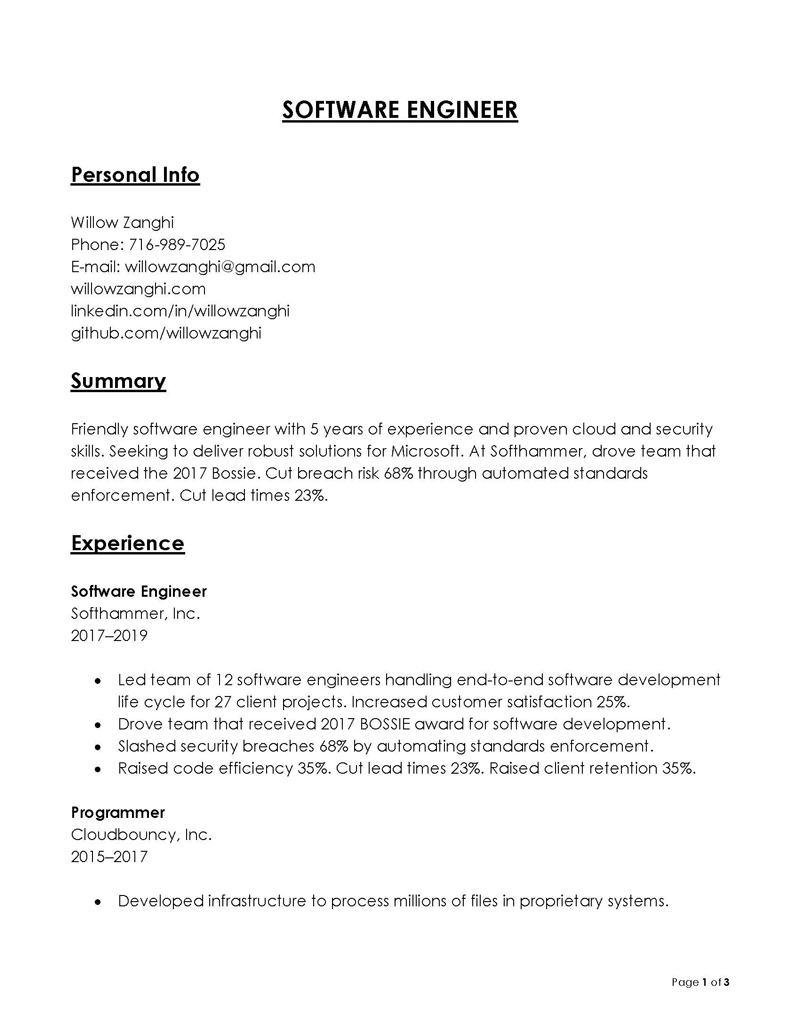
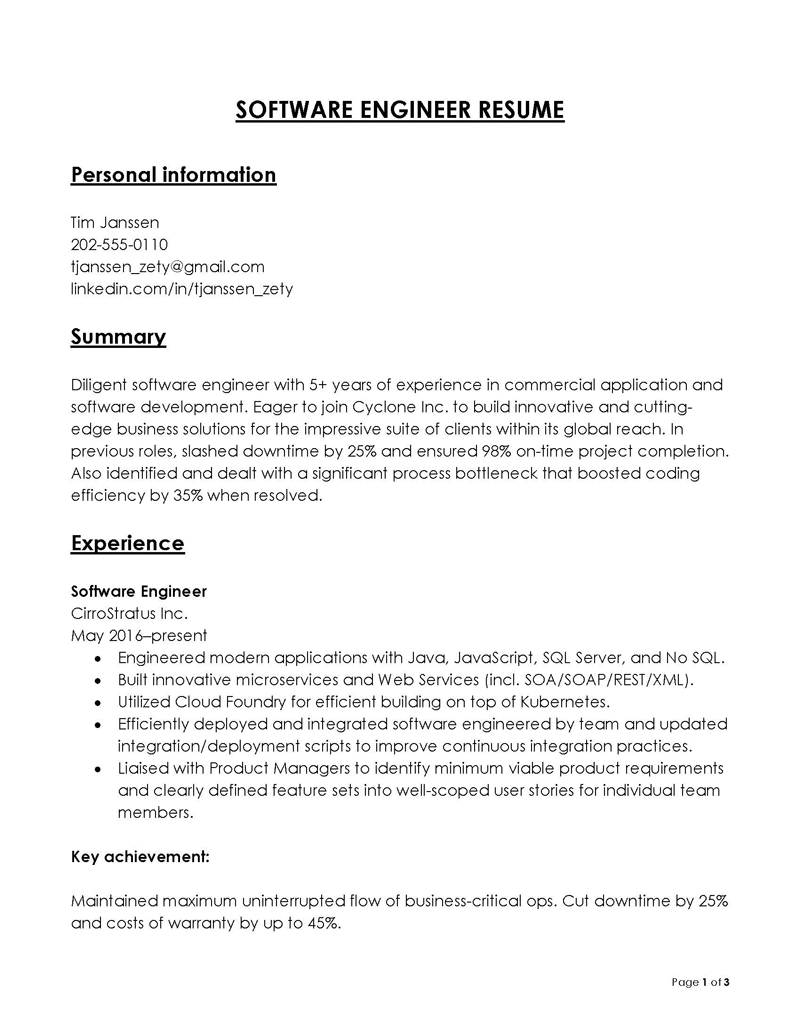
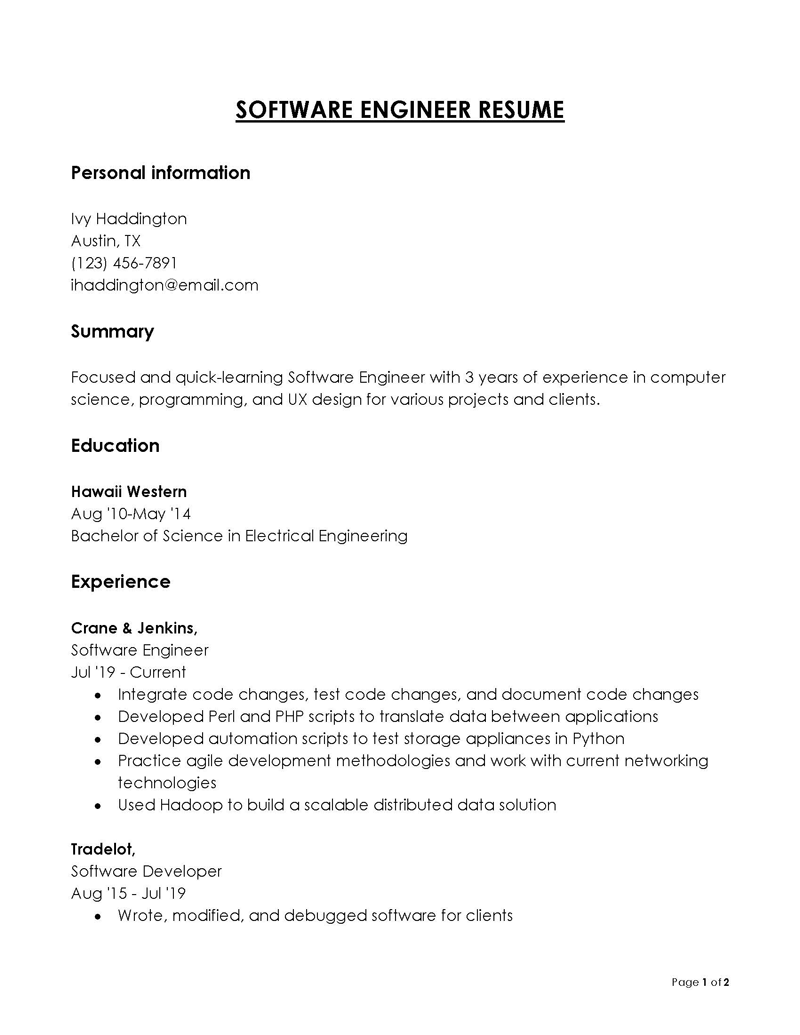
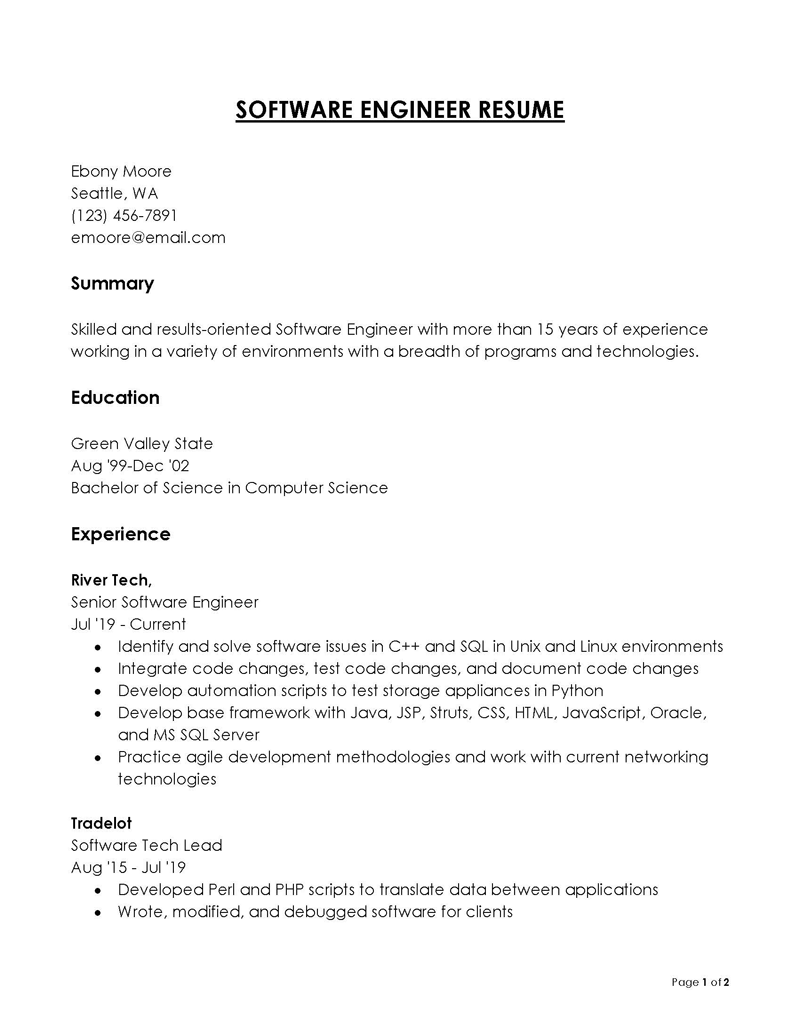
The Main Components of a Software Engineer’s Resume
A well-crafted resume is vital in showcasing the skills, experience, and qualifications of the candidate to potential employers. It serves as a powerful tool for securing interviews and landing a job in a competitive field.
In this section, we will explore the essential components that should be included in a software engineer’s resume, highlighting key elements that can help a candidate stand out and make a favorable impression. From demonstrating technical expertise and proficiency in programming languages to showcasing relevant work experience and educational qualifications, this section will provide valuable insights on how to effectively highlight a candidate’s qualifications in a CV.
Start by providing a header where you will include your contact details and personal information. A specific way to write and format this section is to ensure your resume is visually appealing.
The following details should be included in this section:
- Name: Include your first and last name. If your name closely matches the common names found on Google or LinkedIn, you have the option to include your middle name or an initial to make your name more distinct and easily searchable.
- Job title or branding statement: A job title or branding statement in a CV (curriculum vitae) is a concise and compelling statement that highlights your professional identity and summarizes your skills, experience, and value proposition to potential employers. It is typically placed at the top of your CV and serves as a brief introduction to capture the reader’s attention and create a positive impression.
- Email address: Ensure you use a professional address that includes your name. You can create a separate email address for work and include it in your resume.
- Phone number: The header section should also include your phone number. It is preferable to include your cell number instead of your home number. Ensure that you include your country code to make it possible for the hiring manager to reach you when they call.
- Physical address: You do not need to include your mailing or home address. You may, however, include it to inform your prospective employer that you are a native of the area.
- Website: If you have a personal portfolio website, make sure to include it here. It will provide details of your professional background and projects that will boost your credentials.
- LinkedIn profile: LinkedIn is a widely recognized professional networking platform, and having an active and well-maintained profile can enhance your credibility as a professional. It allows employers to verify your background, qualifications, and professional connections, which can help you establish trust and credibility with potential employers.
- GitHub URL: Including your GitHub URL in your CV can provide evidence of your coding skills, showcase your experience and contributions, demonstrate your technical expertise, enhance your online presence, and help you differentiate yourself from other candidates. However, it is important to ensure that your GitHub profile is up-to-date, well-organized, and relevant to the job you are applying for before including it in your CV.
- Other social media profiles: Include any other relevant social media profile links, such as Twitter, Reddit, and Facebook. Since the hiring manager will probably go through your social media, ensure that you remove or hide any offensive material or lewd pictures.
- Hyperlinks: You can also include any URLs supporting the information.
EXAMPLE
Vanessa Levy
Professional Software Engineer
Giraffe, LI 01274 111 666 0000
levyvanessa@gmail.com
github.com/levyvanessa/
levyvanessa.com linkedin.com/in/levyvanessa/
tip
When providing details for your header section, do not include sensitive information such as your social security number, date of birth, religion, or political affiliations. You may face bias due to this information.
Also, try to be creative and consistent when formatting, but do not overdo it. Ensure that your name is written in bold with a larger font size than the rest of the text. Ensure that you align your text neatly. Use the same formatting style as you did in your cover letter.
Write an Introductory Paragraph
An introductory paragraph in a CV is typically a brief section at the beginning of the document that provides a summary or overview of the candidate’s professional background, skills, and qualifications. It serves as an introduction to the rest of the CV and can be used to capture the reader’s attention and create a positive first impression.
An effective introductory paragraph in a CV should be concise, engaging, and tailored to the specific job or industry the candidate is applying for. It may highlight the candidate’s key strengths, accomplishments, and career goals and can be customized to match the requirements of the target job or employer. The goal of an introductory paragraph is to pique the reader’s interest and encourage them to read the rest of the CV with curiosity and attention.
Your introductory paragraph should include the following:
Resume summary
If you choose to write a resume summary, ensure that you have some professional experience. You will need to summarize your relevant skills, experience, and accomplishments as a software engineer. You can also include details about your education that are relevant to the job position.
EXAMPLE
Professional software engineer with a bachelor’s degree in software engineering and 7 years of experience working at IT Solutions Company. Improved the existing software of the user-interface system by 14 percent. I also managed to identify and resolve system issues to improve its quality using strategic problem-solving skills.
Resume objective
For the objective statement, you should focus on your achievements from college or university because an introductory paragraph like this is preferable if you are a candidate with little or no experience. As a recent graduate, convince the hiring manager to hire you by highlighting your career goals.
EXAMPLE
I am ecstatic to work at ABC Company to further my software engineering career. I look forward to learning and expanding my skills and knowledge, along with accomplishing the organizational objectives. I am also passionate about working in a stimulating position at your reputable organization to build my career and gain professional experience.
If you want to write a captivating introductory paragraph, it is important to understand the elements outlined below:
- Concise and thorough: Ensure that your objective or summary is about 3 to 5 sentences long. It should be thorough, but not too long.
- Important keywords: Ensure you include the keywords mentioned in the job description when listing your skills, educational background, experience, and certifications.
- Quantify achievements: Numbers provide concrete evidence of your accomplishments, allowing you to showcase your results in a measurable and impactful way.
- Tailored: Ensure that this section is tailored to suit the job position and description. You must mention the exact title of the job and inform the hiring manager how you are qualified for the position.
tip
To create a compelling and captivating introductory paragraph, it is recommended to first write your entire resume and then revisit and craft a concise and impactful summary or objective. This strategy enables you to selectively choose crucial information from your resume that will immediately capture the reader’s attention. By following this approach, you can ensure that your resume summary or objective serves as a compelling introduction that immediately captures the reader’s interest, prompting them to delve deeper and consider you a strong candidate.
Include the work experience section
After including an introduction section, proceed to include a work experience section where you will highlight your work history.
Consider the following guidelines when writing this section:
- Order: Start with your job title, the company’s name, the location, and your employment dates. Ensure that you use the reverse chronological order, starting with the most recent to the oldest.
- Active voice: Use active voice, as it is more effective than passive. For instance, “I managed a team of six” instead of “A team of six was managed by me.”
- Quantifiable achievements: Include hard numbers to show your success in your past jobs. Ensure that your achievements are quantifiable.
- Power verb: Use power verbs related to software development, such as constructed and designed.
- Formatting: Highlight your work history and achievements in bullet points. There should be 3 to 5 bullet points and less text in this section.
note
If you are an experienced professional, ensure that this section comes immediately after the introduction. However, if you have little to no experience, this section should come after your education and skills section.
EXAMPLE
Mid-level Systems Software Engineer,
Taurus Company, Aries, SA
June 2017 to August 2022
- Managed a team of 13 software engineers to handle client-based and management projects
- Constructed and tested end-user application, which increased customer satisfaction by 45%
- Designed and modified existing software to guarantee quality at the company
Include your educational qualifications
Tailoring the education section in your CV involves customizing it to highlight the most relevant aspects of your educational background that are directly applicable to the job you are applying for. If you have multiple degrees or certifications, prioritize and highlight the ones that are most relevant to the job you are applying for.
If you have received any academic honors, awards, or scholarships during your studies, mention them in the education section. This can demonstrate your academic excellence and dedication to your field of study.
The following information should be included in the section on educational background:
- Academic qualifications: Write the exact title of your degree, such as a bachelor’s degree or BS or B.S. in Software Engineering.
- School details: Include the name of the university and its address.
- Dates: Include the dates when you graduated. Use the same format as the date you wrote in your work section.
- Format: Use a proper format to ensure that the ATS system recognizes the details in this section.
Some optional elements for this section can be the following:
- GPA: Add your GPA if it is 3.5 or above.
- Relevant coursework: If you have taken coursework that is directly related to the job you are applying for, mention it in the education section. For example, if you are applying for a position that requires expertise in machine learning, highlight relevant coursework or projects related to machine learning, data mining, or artificial intelligence.
- Honors: If you have received any academic honors, awards, or scholarships during your studies, mention them in the education section.
- Publications: Finally, include academic publications and research papers to demonstrate your academic excellence.
EXAMPLE
Bachelor of Science in Computer Science
National University, Bridge, RT,
May 2011–December 2015
Write a skills section
Proceed to incorporate your hard and soft skills in this section. Ensure that you focus on the abilities that the recruiters are looking for by looking at the skills mentioned in their job description.
To write a section about your skills that is effective, try to adhere to the recommendations listed below:
- Relevance: Ensure that you only mention skills that are relevant to software engineering. Reviewing the job description will most likely identify the required skills. Customize your skills section to align with those requirements, highlighting the skills that are most relevant to the job you’re applying for.
- Include a mix of technical and soft skills: You’ll need both technical and soft skills to excel in your role. Include a mix of technical skills, such as programming languages, frameworks, databases, tools, and methodologies, as well as relevant soft skills, such as problem-solving, teamwork, communication, and leadership.
- Be specific and quantify: Avoid vague or generic skills and be specific about your expertise. For example, instead of just mentioning “programming skills,” specify the programming languages or frameworks you are proficient in. Additionally, whenever possible, quantify your skills by mentioning the level of proficiency or the results achieved. For example, “Advanced proficiency in Python with 5 years of experience” or “Led a team of 5 developers in a successful project.
Use a visually appealing format: Organize your skills section in a visually appealing format, such as bullet points or a table, to make it easy for employers to scan and identify your skills quickly.
EXAMPLE
Expert: Python, Cloud Security, JavaScript
Advanced: Software/Hardware Int. Offensive Security, Android & iOS programming.
Include a certification section
Including certifications in your CV can demonstrate your commitment to professional development and showcase your expertise in specific areas. It can also help you stand out from other candidates and increase your chances of being shortlisted for an interview.
Here are some elements that can be included in the certification section:
- Certification name: Clearly mention the name of the certification you have earned. For example, “Microsoft Certified Solutions Developer (MCSD)”, “AWS Certified Developer—Associate”, “Scrum master Certification”, etc.
- Certifying body: Include the name of the organization or entity that issued the certification. For example, “Microsoft”, “Amazon Web Services”, “Scrum Alliance”, etc.
- Date of certification: Mention the date when you obtained the certification. This can help the employer determine how recent your certification is.
- Validity status: If the certification has an expiration date, mention whether it is currently valid or expired. If it is a lifetime certification, you can mention “Lifetime” or “No Expiration”.
- Description: Provide a brief description or highlights of the certification, outlining the skills or knowledge that it validates. This can help the employer understand the relevance and significance of the certification.
- Certification ID or number: Some certifications may come with a unique ID or number. Including this information can add authenticity to your certification.
- Relevance to the job: Highlight the certifications that are directly relevant to the job you are applying for. If you have multiple certifications, consider including only the most relevant ones to avoid cluttering your CV.
EXAMPLE
- Certified Secure Software Lifecycle Professional, March 2017
- CIW Web Development Professional, August 2019
Projects
Include a section that showcases your relevant projects, particularly if they demonstrate your technical skills or align with the job you’re applying for. Mention the project name, your role, the technologies used, and the outcomes or impact of the project.
- Project name: Clearly mention the name of the project you worked on. This can help the employer understand the context of your work.
- Description: Provide a brief description of the project, including the purpose, scope, technologies used, and any challenges or complexities you encountered. This can give the employer an idea of the scale and complexity of the project.
- Your role: Clearly mention your role in the project, such as developer, team lead, or project manager. Describe your responsibilities, tasks, and contributions to the project.
- Technologies used: List the programming languages, frameworks, databases, tools, and methodologies that you utilized during the project. This can demonstrate your technical expertise and proficiency in relevant technologies.
- Outcomes or results: Highlight the outcomes or results of the project, such as successful completion, achievements, impact on business or users, or any awards or recognition received. Use quantitative or qualitative measures, such as increased efficiency, reduced costs, improved performance, or positive feedback, to showcase the success of the project.
- Team collaboration: If the project involved working with a team, mention your role in the team, the size of the team, and how you collaborated with team members. This can showcase your teamwork, communication, and leadership skills.
- Link to the project: If possible, include a link to the project, such as a GitHub repository, a website, or a demo. This can allow the employer to review your work and assess your skills.
- Optional: Depending on the nature of the project, you may include additional information, such as project duration, client or industry information, notable challenges or solutions, or lessons learned.
EXAMPLE
Fingerprint voting system
The project solves irregular voting since an individual’s fingerprint is required during voting, especially online. This project aimed to ensure that online elections were successful and could be easily tracked.
Skills used to accomplish this project:
- JavaScript
- Python
- Offensive Security
Include other additional sections
Other additional sections that you can include in your resume include the following:
- Language proficiency: Include any languages you speak well along with your level of proficiency. This is especially beneficial if you are a job candidate applying to an international company. For example, English (Native) and French (Full working proficiency),
- Volunteer work: Mention any volunteer work that you may have been involved in. This will show your dedication to the community and that you value more than just material things.
- Memberships and affiliations: List any professional organizations you are an active member of or affiliated with to show your commitment to computer science and software engineering.
- Hobbies and interests: You can include some of your hobbies and interests to share some personal details about you.
- Courses: Make sure to highlight any courses you took that helped you develop particular skills in this section. For instance, a leadership course, etc.
- Additional activities: You can also include any life experiences and activities that will increase your chances of being hired. For example, you can include the conferences you attended or any other interests related to computer science.
Some Important Tips for A Strong CV
Here are some specific factors that can make a CV stand out:
- Technical expertise: Highlight a comprehensive list of programming languages, frameworks, databases, tools, and methodologies that the software engineer is proficient in. Providing specific details of projects or technologies used can demonstrate the depth of technical expertise.
- Projects and achievements: Showcase relevant projects, their scale, complexity, and outcomes or results achieved. Highlighting specific achievements, such as successful project completions, awards, recognition, and quantifiable results, can demonstrate the candidate’s impact and contributions.
- Problem-solving skills: Emphasize the ability to analyze and solve technical challenges, including examples of identifying and resolving issues and providing innovative solutions. Demonstrating critical thinking, troubleshooting, and debugging skills can set a software engineer apart.
- Innovation and creativity: Highlight any innovative projects, unique solutions, or creative approaches to problem-solving. Demonstrating a track record of bringing new ideas, approaches, or technologies to projects can showcase the candidate’s creativity and potential for innovation.
- Continuous learning and professional development: Showcase any relevant certifications, professional courses, or continuous learning efforts. Highlighting a commitment to staying updated with the latest technologies and industry trends can demonstrate the candidate’s motivation to continuously improve and excel in their field.
- Strong communication and teamwork skills: Highlight soft skills such as communication, teamwork, collaboration, and leadership. Providing examples of how the candidate has effectively worked with cross-functional teams, clients, or stakeholders can showcase their ability to work well in a collaborative environment.
- Clear and professional formatting: Use a clean and professional format for the CV, with clear headings, bullet points, and a well-organized layout. Avoid lengthy paragraphs or unnecessary details and ensure the CV is easy to read and visually appealing.
- Keep sentences concise: Avoid long, complex sentences that contain multiple ideas or clauses. Instead, aim for shorter sentences that convey one clear idea or point at a time.
Example (Grunt Sentence)
I have experience in developing web applications using different programming languages such as Java, C++, and Python, and frameworks like Spring, Angular, and React, as well as databases such as MySQL, MongoDB, and PostgreSQL, and tools like Git and Jenkins.
Example (Improved Sentence)
“I have experience in developing web applications using Java, C++, and Python, as well as frameworks like Spring, Angular, and React. I am also proficient in working with databases such as MySQL, MongoDB, and PostgreSQL, and tools like Git and Jenkins.”
Key Takeaways
- The primary purpose of a resume is to help you impress potential employers by showing them the qualities you will bring to the organization if hired.
- It is crucial to strategically introduce your skills and knowledge to employers, as this will give you a competitive advantage over other applicants. Therefore, it is essential to label your best attributes in the resume.
- With constant technological advancements, software engineers are required to constantly refresh and gain new knowledge. Therefore, it is important to highlight any fresh courses or certifications in your resume.
- Software engineers should use their research skills to learn about a company and its policies. This will help them to make a resume that meets the demands of the recruiters.








